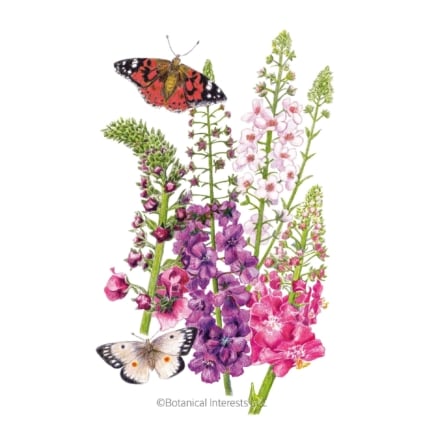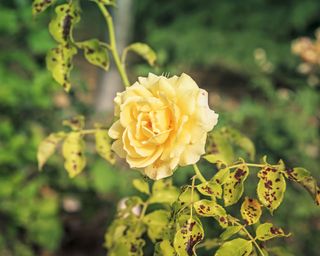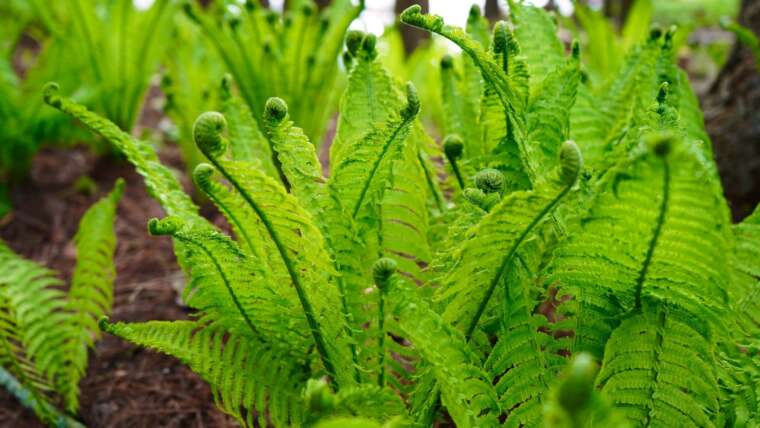Perennials are amazing in gardens—they produce flowers, seeds, and leaves endlessly each year. Pollinators visit the flowers and learn where they sprout so they can return annually. Us gardeners learn to rely on them for fruits and vegetables, like artichokes, asparagus, and rhubarb. Plus, their leaves and stems provide valuable habitat space for local wildlife.
Perennials also take a break during the winter or summer and need much less care than during their growing season. They offer you a rest from caretaking so you can plan, redesign, and reinvest in your garden. Then, they surprise you as they sprout from bare soil when the weather warms or cools to their liking.
Start any of these 15 perennials during fall in your region. Some appreciate a head start before the first frost, while others prefer wintery cold temperatures to thrive. Still, others grow throughout the winter in warm climates. We’ll see what they look like, how to start them, and what they offer you and the environment. Try any one of them to turn your garden from drab to fab!
Mullein
‘Shades of Summer’ Verbascum Seeds
Blue Penstemon

‘Rocky Mountain Blue’ Penstemon Seeds
Greek Oregano

‘True Greek’ Oregano Seeds
Blackberry Lily
 Orange flowers with blackberry-like seed heads add vibrant interest.
Orange flowers with blackberry-like seed heads add vibrant interest.
Blackberry lilies aren’t true lilies—they’re irises! They sprout orange flowers with red-brown dots in clusters that resemble Columbia lily petals. From late summer through fall, black seeds emerge from green, papery seed pods. This is why we call them blackberry lilies—their seed heads resemble ripe blackberries.
Drought tolerant and a lover of full sun, this iris thrives in borders, containers, or in-ground beds amongst other perennials. In zones 8 and above, the green foliage may persist through the winter with the seed heads, offering four seasons of interest. Their flowers attract hummingbirds and pollinators, and they create a pollinator garden wherever they sprout.
Start blackberry lilies by planting seeds in the fall. They won’t germinate until spring; you’ll notice iris fronds sprouting from bare soil when they do. You may also start them in pots outdoors to keep a closer eye on the sprouting seedlings. Transplant them in your garden after all danger of frost passes.
Western Columbine
 Yellow and red blooms attract hummingbirds and add vibrant color.
Yellow and red blooms attract hummingbirds and add vibrant color.
Western columbine is a native perennial from western North America. It’s perfect for gardeners wanting a pop of yellow and red color. The flowers sprout with spurs that hummingbirds, bees, and flies drink nectar from; after successful pollination, they form seeds that fall to the ground in autumn.
Many columbines thrive throughout the U.S., and some are native to Japan and parts of Europe. Some prefer a fall sowing like western columbine, while others like warm spring temperatures. Select one native to your area, or find a cool cultivar at your local nursery.
Sow western columbine in the fall, and you mimic its natural growing cycle. This perennial is exceptionally cold hardy but needs some time to sprout before first frosts. Sow seeds four to six weeks before your first fall frost, and water them well. They’ll sprout roots that keep them strong during winter freezes, then grow foliage in spring.
Bloody Dock
 Red-veined greens are hardy and add vibrant color to gardens.
Red-veined greens are hardy and add vibrant color to gardens.
Bloody dock has a violent name, but it’s a gorgeous leafy green that’s incredibly hardy. It sprouts edible green leaves with red veins and inconspicuous flowers along the stems from summer through fall. They’ll turn into tiny brown seeds that fall to the ground and germinate.
Bloody dock does have a lot of oxalates, so consider using them in moderation. I have a few of these perennials in my raised beds, and I often put their leaves in smoothies. They taste similar to Swiss chard or beet leaves, and they make excellent cooked greens.
Start bloody dock seed at least two months before your fall frost date. They’ll germinate and grow into frost-hardy seedlings. Although they tolerate cold temperatures, a mulch or compost layer around their roots will keep them warm and secure all winter.
Artichoke ‘Green Globe Improved’
 Gigantic flower heads add beauty and flavor to your garden.
Gigantic flower heads add beauty and flavor to your garden.
Artichokes provide delicious flower buds in summer and are the perfect vegetables to grow no matter where you garden. They’re perennial in zones 7 through 10 but can grow as annuals anywhere. Fall is the best time to start them from seed in mild climates where they’re perennial.
‘Green Globe Improved’ is a hardy cultivar with gigantic flower heads. Harvest them before they open up, then steam and eat them with a yummy sauce like ranch, barbeque, or spicy mayo. You can also grow artichoke ornamentally and enjoy its purple, spikey blossoms. When it flowers, it attracts bees, butterflies, and pollinating flies.
Start ‘Green Globe Improved’ outdoors in the fall in zones 7 through 10. Plant them a quarter inch deep in fertile, free-draining soil, and keep them moist. You can also start them indoors in pots in early fall, then transplant them outdoors four weeks before your last frost in spring.
Yarrow ‘Colorado Blend’
 Sow seeds in the fall for colorful summer blooms and pollinators.
Sow seeds in the fall for colorful summer blooms and pollinators.
Sow yarrow in the fall for perennial blooms that boost biodiversity. Yarrow flowers provide valuable nectar for hungry pollinators in summer. They form flat sections that work perfectly as landing pads for bees. Watch a yarrow flower or two, and you’ll see bumblebees lounging about between their nectar sips.
Direct sow yarrow seeds in autumn, and they’ll germinate in spring. You’ll see little rosettes of fernlike foliage sprout from the seeds. Give your seedlings water when their soil dries, full sun, and a helping or two of compost a year. They’ll thrive in these conditions and tolerate drought and hard frosts after they establish themselves.
‘Colorado Blend’ is a gorgeous selection of yarrow cultivars with red, yellow, pink, and peach blossoms. Sow a handful of seeds in a border or raised bed for an explosion of summer color.
Garlic Chives
 Sow in autumn for tender, flavorful greens all year.
Sow in autumn for tender, flavorful greens all year.
Garlic chives combine the best of two flavorful onion relatives, garlic and chives. This species is unique in that it has a mild flavor of onion, honey, and garlic. It’s common in Asian cooking, either chopped as a scallion, or whole in soups, stews, and stir fry.
Garlic chives sprout perennially in zones 3 through 9 and are annuals elsewhere. Grow them in pots and bring them into your home for the winter in cold winter zones. They’ll provide an endless supply of tender, green shoots when they receive bright light and regular water indoors.
Start garlic chives from seeds outdoors in autumn. Direct sow the seeds eight weeks before your first average frost, and keep the soil moist. They’ll germinate and stay hardy throughout the winter, then put on fresh growth in spring.
Sweet Alyssum ‘Oriental Nights’
 Tiny clusters of colorful flowers attract pollinators and charm.
Tiny clusters of colorful flowers attract pollinators and charm.
Sweet alyssum is a beautiful perennial to stuff in between your vegetables and fruit crops. It’ll sprout tiny clusters of flowers all along its stems that lure bees and pollinators to the site. It’s a short-lived perennial in zones 5 through 11 but grows well as a summer annual anywhere.
‘Oriental Nights’ is a unique sweet alyssum cultivar with purple, pink, and white blooms. They start white and turn darker over time. Cut the flowers for bouquets, or eat them in salads! They add a delicate mustard flavor to any dish you add them in.
Start sweet alyssum in the fall in gardens with mild climates. Direct sow seeds on the surface of moist soil—they’ll germinate in the winter for early spring blossoms. Shear your plants after they bloom to encourage a second eruption of flowers.
Lavender ‘Vera’
 It is a fragrant, drought-tolerant shrub perfect for sunny coastal gardens.
It is a fragrant, drought-tolerant shrub perfect for sunny coastal gardens.
Lavender is a must-have herb in any garden, no matter its style. It’s incredibly drought-tolerant and thrives with excess sunlight in poor soils. Native to the Mediterranean region in Europe, this shrub appreciates coastal conditions that match its home. Give it regular water during the growing season and well-draining soil for optimal growth.
Lavender is perfect for cut flower gardens, herbal plantings, and low hedges. Its leaves, flowers, and stems are incredibly fragrant, and they give off a pleasing smell that calms and soothes. Cut a few flowers to dry, and they’ll make a fragrant bouquet that’ll last over six months!
‘Vera’ lavender is an English cultivar with slender flower clusters and tall stems to about three feet tall. It’s a classic variety that gardeners love, as it needs little care or maintenance. Surface sow ‘Vera’ seeds outdoors in late fall for spring germination.
Echinacea ‘White Swan’
 Stunning white blooms on tall stems add elegance to gardens.
Stunning white blooms on tall stems add elegance to gardens.
You may have heard of the native purple coneflower, but have you heard of its white-flowered cousin? ‘White Swan’ echinacea is perfect for white flower-loving gardeners who want native plants. It’s a selection of purple coneflower with snow-colored petals on big, yellow heads. They look stunning in moon gardens alongside other pasty blooms.
Echinacea is an ideal perennial for native, pollinator, and ornamental gardens. It sprouts up out of the soil in early spring, flowers during summer, and goes dormant in the fall. The brown, spiky seed heads persist in the winter and offer nutritious seeds to hungry birds. Leave them to help these creatures and to have winter interest in your garden!
Direct sow ‘White Swan’ seeds at least eight weeks before fall frost. They’ll germinate and go dormant, creating strong root structures that keep them safe throughout winter. You’ll notice new shoots sprouting when the weather warms from spring to summer.
Oregano ‘True Greek’
 Aromatic Mediterranean herb adds savory flavor and thrives in the sun.
Aromatic Mediterranean herb adds savory flavor and thrives in the sun.
Like lavender, oregano is a Mediterranean herb with plenty of uses and benefits. It’s incredibly aromatic and flavorful, adding an herbal, savory flavor to sauces, soups, and marinades. Oregano sprouts perennially in temperate zones 4 through 8 and thrives under full sun with well-draining soil. Grow it amongst thyme, rosemary, and lavender to create a Mediterranean-style herb garden.
‘True Greek’ is the ideal variety for cooking and eating, as it’s pungent, powerful, and flavorful. Other oregano cultivars work well in recipes but not nearly as well as ‘True Greek.’ Use the leaves fresh or dry and store them for a yearlong supply of culinary herbs.
Sow seeds two months before the fall frost date in your area, giving them ample time to sprout and grow hardy before winter. They’ll stay dormant in wet, freezing weather and sprout new leaves and stems in spring. Add a layer of mulch or compost around their roots during the winter to keep them warm, safe, and secure.
Penstemon ‘Rocky Mountain Blue’
 This frost-tolerant perennial blooms with purple-blue flowers and attracts pollinators.
This frost-tolerant perennial blooms with purple-blue flowers and attracts pollinators.
Penstemons, or beardtongues, are delightful herbaceous perennials with delicate, foxglove-like flowers. Many native penstemons thrive throughout North America, including Penstemon strictus. This species attracts native flies, bees, and beetles to the site with delicious nectar and pollen.
‘Rocky Mountain Blue’ is an ideal garden cultivar, as it tolerates frost, drought, and poor soil conditions. It sprouts purple-blue flowers in the dozens, and they attract native insects just like the species blossoms do. Plant a few in your borders and you’ll enjoy a month of summer blooms, ornamental seed pods that follow, and red-green fall color on the foliage.
Sow ‘Rocky Mountain Blue’ seeds directly in the soil where you’d like them to grow from late fall through winter. They need a few weeks of cold temperatures and will germinate as the weather warms in spring.
Mullein ‘Shades of Summer’
 This hardy perennial blooms in striking shades of lavender and pink.
This hardy perennial blooms in striking shades of lavender and pink.
Like common mullein, purple mullein Verbascum phoeniceum forms tall, thick flower stalks. Unlike normal mullein, this purple type sprouts lavender flowers that stand out more than the dainty, common yellow ones. It’s a hardy, short-lived perennial that provides cover wherever you need it.
Many mullein varieties exist with various heights, flower colors, and fragrances. ‘Shades of Summer’ collects the best ones into a single seed packet. Sow a handful of these seeds for perennial blooms in purple, pink, rose, and white. Plant dozens en masse, and you’ll enjoy a stunning presentation of blooms that both you and pollinating bugs can appreciate.
Purple mullein is a quick grower, sprouting from seeds into a mature, flowering adult in a single season. Start ‘Shades of Summer’ seeds in early fall, at least two months before your first frost. Plant them on the soil’s surface, and keep the ground moist while they sprout.
California Poppy ‘Mikado’
 Vibrant orange-red flowers with yellow centers add striking color.
Vibrant orange-red flowers with yellow centers add striking color.
California poppies grace wild landscapes throughout the West Coast. These perennial wildflowers grow where not much else will, along roadsides, ditches, and disturbed lands. Their seed pods spread the seeds far and wide when they burst open, allowing this species to creep into new sites.
Most California poppies are yellow, orange, or a mixture of the two colors. ‘Mikado’ is a beautiful cultivar with orange-red blossoms and yellow centers. It’s a perfect specimen for ornamental gardens, as it’s gorgeous and hardy. It’ll tolerate drought, frost, and wet conditions in its native range and grows outside of this range in hardiness zones 8 to 10.
Sow ‘Mikado’ seeds during early fall for early spring blooms in cold climates. In mild climates, direct sow them in the fall for winter and early spring blooms. California poppies live a few years before dying, but they reseed readily. Leave spent flowers on your plants, and they’ll repopulate your garden for years with their seeds.
Shasta Daisy ‘Alaska’
 Bright white blooms on tall stalks brighten any garden space.
Bright white blooms on tall stalks brighten any garden space.
Previously a chrysanthemum, Shasta daisies are now in their genus Leucanthemum. They’re extremely tough wildflowers with three-inch wide white blooms. They’re an old hybrid of other daisies, and all perform well in warm North American landscapes. Some perform so well that they’re classed as invasive weeds!
Shasta daisies spread rampantly through seeds each autumn—deadhead spent blooms to prevent reseeding, or collect the seeds and sow them where you’d like. ‘Alaska’ is a hardy cultivar with a long American history; Luther Burbank bred four different daisy species together to create this one in California. It’s a longtime favorite of gardeners worldwide, as it produces big blossoms on tall, free-standing stalks.
Sow ‘Alaska’ Shasta daisy seeds directly in the soil outdoors at least two months before your fall frost date. They’ll sprout and go dormant in winter, spreading their roots underground. By spring, sprouts will spring up and turn into flowering stalks.
Lanceleaf Tickseed ‘Double Sunburst’
 Bright orange-yellow blooms on tall stems attract lively pollinators.
Bright orange-yellow blooms on tall stems attract lively pollinators.
Lanceleaf tickseed is a native wildflower of the U.S. Its lance-shaped green foliage decorates tall, three-foot stems. On top of the stems lie yellow daisy-like flowers that lure pollinating insects wherever they sprout. Lanceleaf tickseed is incredibly resilient and tolerates excessive heat, drought, moisture, and humidity—they’ll even thrive in clay or sandy soils!
‘Double Sunburst’ is a unique variety with two layers of petals on each flower head. The orange-yellow petals stand out under direct sunlight, shining bright to attract hungry bugs and birds. Cut blooming buds with stems attached for floral bouquets. Pair them with blue, orange, and yellow flowers for a lovely, colorful arrangement.
Start this tickseed in your garden two months before your first frost in autumn. Direct sow ‘Double Sunburst’ seeds on the soil’s surface, and keep them damp while they sprout. This cultivar lives a long time as a perennial, giving you endless blooms for decades. It may reseed—allow it to if you’d like, or cut the spent flowers to prevent seed formation.




